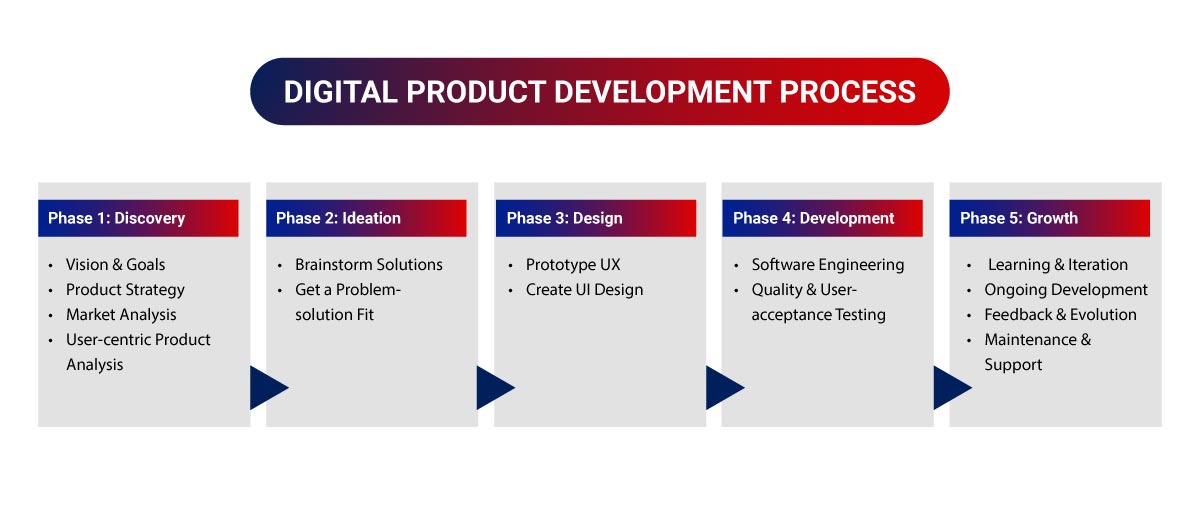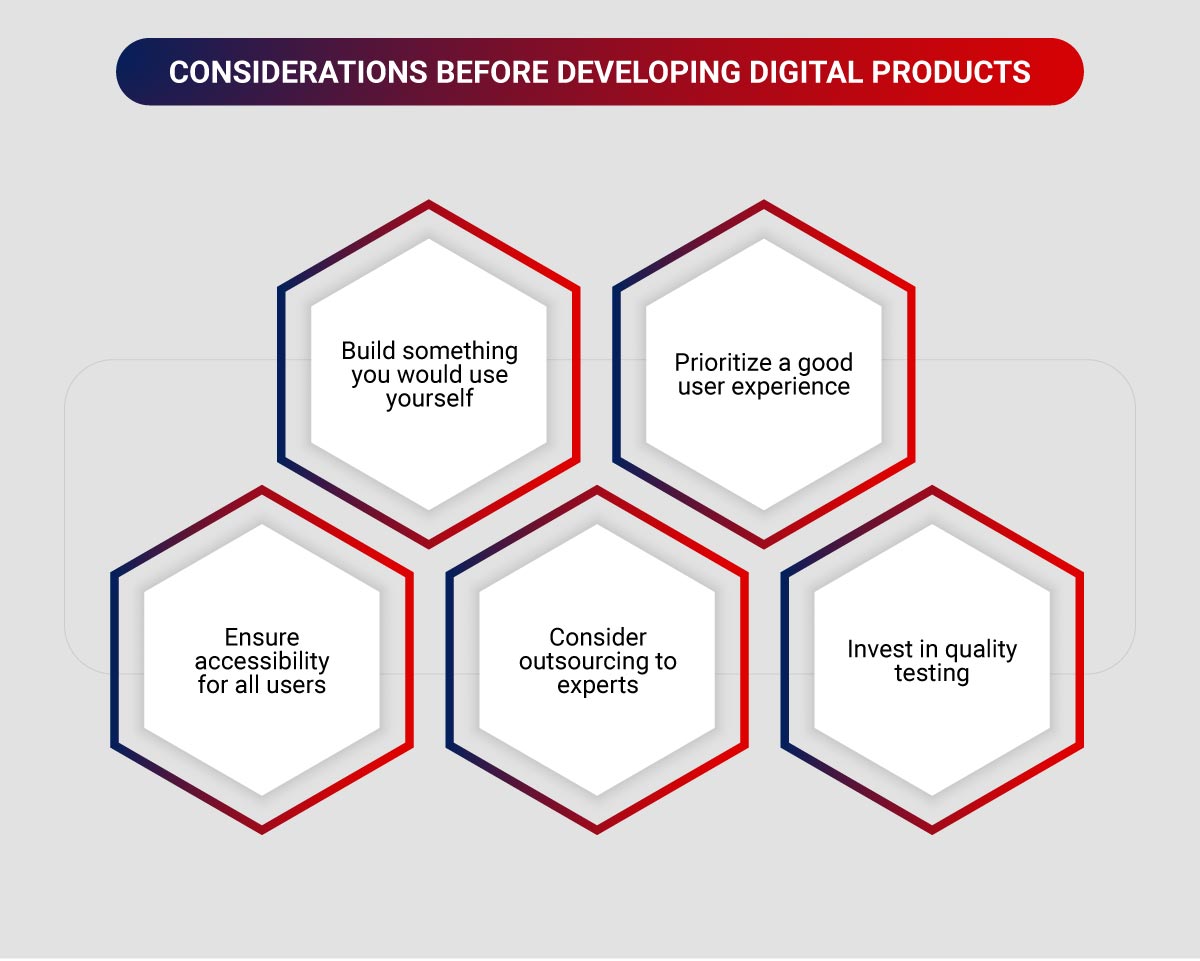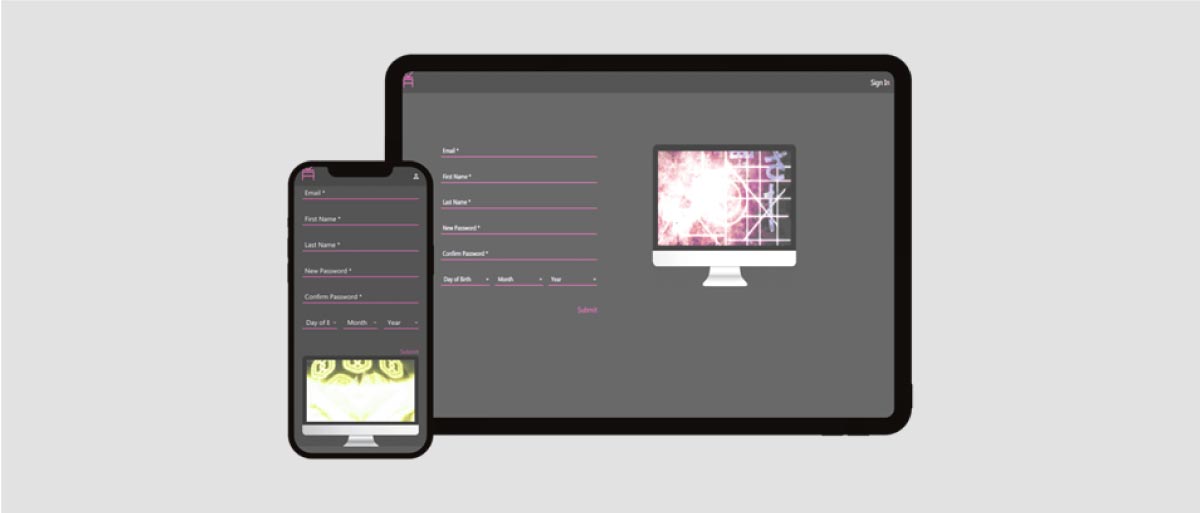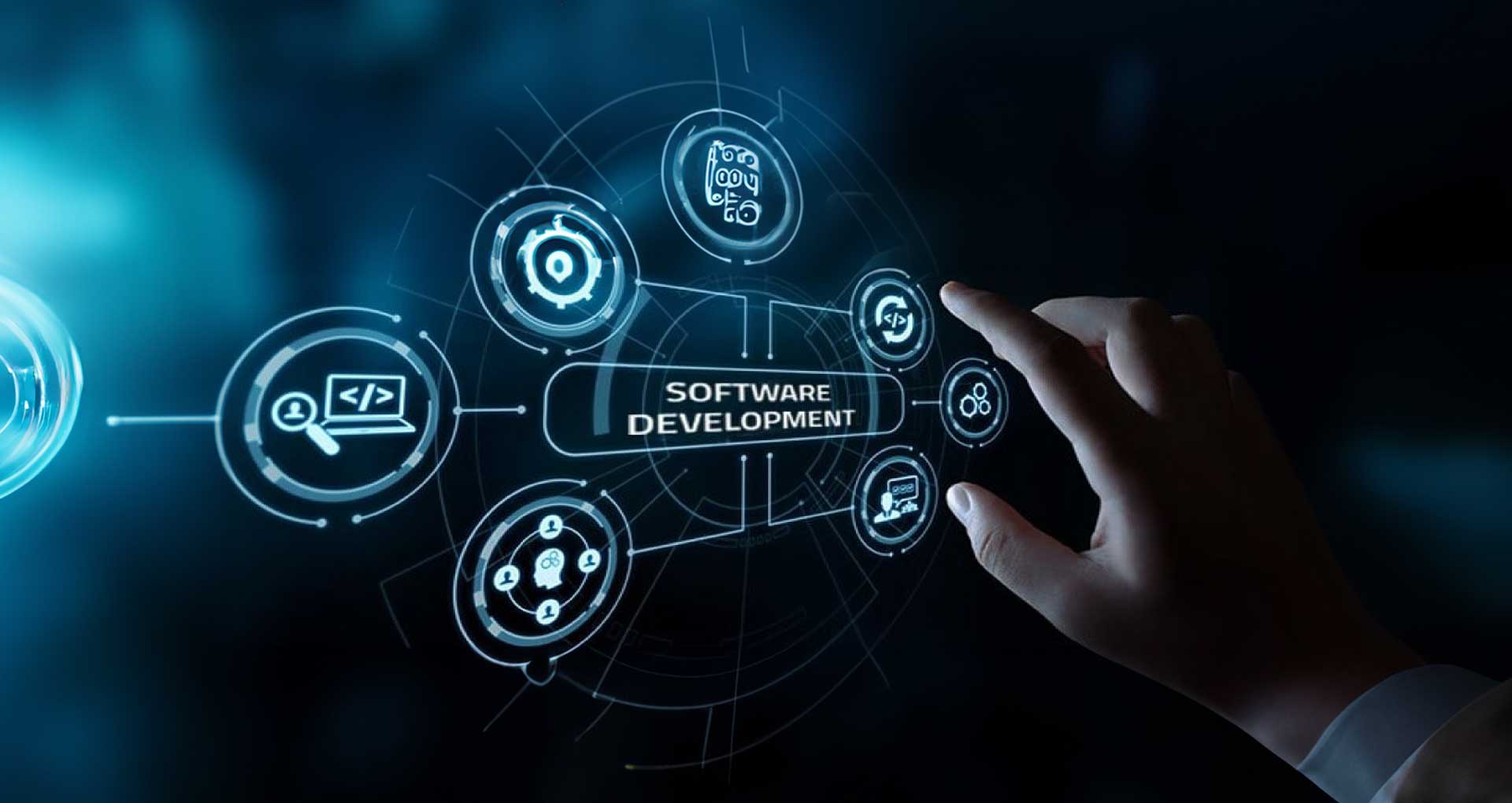Back in 2007, Apple didn’t just launch a phone; it introduced a new way of living. The iPhone was more than hardware. It was the outcome of brutal editing, smart design and persistent attention to user behavior.
Today, whether you’re a bootstrapped startup dreaming big or a legacy brand struggling to stay relevant, the stakes are just as high. Every industry is being redefined by digital products that break through barriers and deliver real value. Miss the mark, and you risk fading into obscurity. Get it right, and you could be the next success story.
This guide cuts through the noise and gets into the stuff that actually matters – process, benefits, considerations, challenges and their solutions and approaches to help you navigate the ever-changing realm of digital product development.
What Is Digital Product Development?
Digital product development is a holistic process that involves creating, refining, and launching various digital products. It would include software applications, websites, mobile apps, or digital services. Further, it would involve conceptualizing, designing, developing, testing, and deploying these products to deliver valuable and user-centric solutions. It combines creativity, technical expertise, and user-centric design to provide practical and engaging experiences. To ensure the success of a digital product, a skilled team of professionals, including product managers, designers, developers, and quality assurance testers, collaborates. Their expertise and collaboration help in creating successful products. It involves leveraging technologies, frameworks, and tools to bring ideas to life and continuously iterate on them based on user feedback and market demands.
The process typically starts with gathering requirements and understanding user needs, then designing wireframes and prototypes to visualize the product’s structure and functionality. Development teams then code the product, integrating features and functionality while ensuring its performance, security, and scalability. Iterative testing and refinement are conducted to improve the user experience and address issues or bugs. Finally, the product is deployed and monitored for ongoing maintenance and updates.
So, Why Should You Go for Digital Product Development?
81% of respondents in a study agree that a positive user experience of a digital product favorably impacts business growth. Although the adoption of digital product development is increasing rapidly, it isn’t 100% yet. There are several significant reasons to build digital products. They include:
- Quick response to changing user expectations: With the constantly changing market dynamics and user demands, the continuous evolution of your digital product can keep it relevant. So, adopting traditional development processes that are slow and unresponsive is not an option. You can meet user needs and provide personalized solutions with digital products.
- Gain a competitive edge: Your innovation must outperform your competitors, and you must be the first to offer updates that meet customers’ preferences. So, it would help if you leverage new technologies for your digital products.
- Revenue Generation: Launching or improving a new product in uncertain economic times can be challenging but rewarding. Digital products can help you tap into new revenue streams, like how the dining, hospitality, education, and retail industries have adapted to meet new demands.
Digital Product Development Process
The digital product development lifecycle involves several phases or stages, each with multiple steps or processes. They collectively ensure the success of your digital product. Although it may vary depending on your unique requirements, generally, the below-mentioned process is followed.

The stages in the development process of a digital product include:
Phase 1: Discovery
It is vital in the digital product development journey as it helps minimize risks and uncovers potential problems early on. It involves actively engaging with end users to identify gaps and validate the need for a solution. This phase helps stakeholders assess the viability of their product concept and prevents the development of solutions that do not align with user needs. The discovery phase saves time and resources in the long run by addressing user pain points from the beginning. It includes:
- Vision and goals: Defining your project’s vision and expected outcomes is essential while focusing on why you must build something and not just what you need to develop. You can understand stakeholders’ and users’ needs and expectations by interviewing them. It also helps identify opportunities that align with your goals.
- Product strategy: Implementing the vision and providing direction to the project team is vital. The strategy includes a clear roadmap with well-defined objectives, measurable success and analytics metrics, value propositions, etc.
- Market analysis: This process aligns product strategy with market needs and expectations by conducting competitor analysis, gathering market information, analyzing trends, and evaluating how your product fits the market.
- User-centric product analysis: This includes analyzing your proposed product from the perspective of a particular category of users and identifying if it provides them value. The process helps identify specific features and functionalities for your product.
The deliverables at the discovery stage include the Product Requirements Document (PRD) and a project roadmap. They help determine the Minimum Viable Product (MVP) and the required functionalities.
Phase 2: Ideation
In the ideation phase, you brainstorm solutions to address the problems identified in the discovery stage, aiming to build a product that meets customers’ needs. By thoroughly understanding the problem during discovery, you can explore various solutions and strive for a problem-solution fit.
You can use internal brainstorming, the five-whys approach, surveys and feedback, competitor analysis, the 6-3-5 method, social media listening, and more to identify potential solutions. These methods tap into group collaboration, problem analysis, customer insights, and creative thinking to generate ideas for your digital product.
Phase 3: Design
This phase involves creating both UX (User Experience) and UI (User Interface) designs on how your digital product will look, what kind of user experiences it will offer, etc. It includes:
- Prototyping UX: To build a user-centered digital product, creating a basic prototype showcasing the product’s functionality and positive user experience is essential. Approaches like design thinking, simplified workflows, and testable prototypes help achieve this goal. By learning from end-users through usability testing, you can identify the best solutions to address their needs and preferences.
- Creating UI design: This process starts with the development of functional wireframes. They later evolved into more comprehensive designs based on user feedback. UI design includes visual elements like images, color, typography, and layout to create an enjoyable user experience. It also includes data visualization techniques that help present information in a user-friendly manner, using charts, tables, and graphs.
At the design phase of the digital product development lifecycle, the deliverables include wireframes, design assets like images, media, etc., and style guides like logos, color, font, etc.
Phase 4: Development
Building a digital product is an iterative process that involves coding and programming. The development team brings the product design to life at this stage. So, it consists of utilizing various technologies like software tools, programming languages, frameworks, etc. Creating a reliable, efficient, secure, and scalable product requires using best industry practices, latest trends, and a skilled team of developers. This stage also includes the development of essential functionality and features to make your digital product work. It would consist of the following:
- Software engineering: This process involves the development team applying their skills and experience to build your desired digital product, whether a web, mobile, enterprise application, system, or platform. They utilize multiple technological services like Cloud, IoT, Data Analytics, AI, ML, and more to meet your product’s technical requirements.
- Quality and user-acceptance testing: The testing team conducts various tests to ensure the developed product works as intended and meets user expectations for requirements and experiences.
The deliverable at this development stage is the Minimum Viable Product (MVP). It has a user interface and basic functionality that meets the fundamental requirements identified at the design stage. It is the initial step to advanced product development fueled with faster release cycles that make areas of improvement visible.
Phase 5: Growth
As you fine-tune your product based on feedback from the minimum viable product (MVP), thinking about growth and reaching a larger audience is crucial. The development team can help your product expand and scale from the initial design and development stages. The steps for the growth stage of developing digital products include:
- Learning & Iteration: QA testing remains an ongoing process throughout development and even after initial market releases. It is crucial to create comprehensive documentation at every step. User-friendly documentation ensures that users fully grasp and utilize the product. As you go on introducing new features, continuous testing becomes highly essential. If a step is not functioning correctly, maybe certain features require adjustments. Users may also request additional options within your product. So, it is vital to learn and iterate repeatedly until the product is fully prepared for its live launch.
- Ongoing Development: The period after launching your digital product is the maturation phase. It includes integrating new features, updates, customer support, and software engineering if required. This ongoing development process allows your digital product to expand, stay current with trends, address emerging needs, and enhance user experience.
- Feedback & Evolution: Feedback is vital in keeping your product relevant to users’ requirements and expectations. It helps you realign the product to emerging needs and market trends. So, your digital product can evolve in terms of user experience, performance, security, quality, functionality and more.
- Maintenance & Support: Your development process is incomplete without continuous support and maintenance. You don’t want bugs or errors harming your product’s reputation post-launch. Hence, planning for this stage from the start is essential. You need to allocate resources to maintain your product at all times and ensure it stays relevant.
What Are the Business Benefits of Digital Product Development?
Collaborating with a skilled and experienced tech partner is essential to leverage the many advantages of developing digital products, from creating an income stream to building a solid brand. It will help you get the product that meets users’ expectations. The list comprises,
- Customer-Centric Approach: The digital product uses the latest technology to maximize user experiences.
- Efficiency: You get visibility at every development stage, reducing workflow friction. It enhances efficiency in iterations and workflows with timely decisions.
- Data Collection: Your digital product can store essential customer data like payment information to make future interactions easy. It can also store other business information and analyze trends that can help create new revenue streams.
- Low Product Downtime: The digital product development process helps identify errors and bugs early and resolves issues to enhance the final product.
- Cost Savings: You can keep enhancing your digital product based on user feedback at a lower cost and stay relevant in business.
- Future-Readiness: You build a scalable digital product that can constantly improve to meet escalating user expectations and needs.
- Business Insights: The digital product collects and uses data to enhance marketing and advertising initiatives. It helps attract customers, offers personalized experiences, and rewards loyal customers while increasing brand loyalty.
Top Considerations Before Developing Digital Products
Before developing digital products, you must consider the following factors to increase the chances of creating a successful product that meets user needs, delivers a great user experience, and remains competitive in the market.

- Build Something You Would Use Yourself: Ensure the product provides value by using it personally. If you wouldn’t use it, question its usefulness to others.
- Prioritize a Good User Experience: You must test your product and gather feedback from real users. It includes identifying pain points and enhancing the user experience. Also, preserve valuable aspects of your product while eliminating barriers.
- Ensure Accessibility for All Users: It would help to consider the requirements and preferences of individuals with disabilities. Engage with them to understand their challenges and make necessary changes to improve accessibility.
- Consider Outsourcing to Specialists: If your expertise is limited, consider outsourcing product development to a digital product development company like ours. You can benefit from their experience in delivering quality products. They can transform your vision into a usable digital product.
- Invest in Quality Testing: You can understand user preferences and needs through thorough testing. Use data to guide your digital product’s evolution and ensure ongoing relevance and user satisfaction.
Challenges of Digital Product Development and Their Solutions
Creating a digital product is a high-stakes process that blends strategy, design, engineering, and market fit. Each phase introduces risks that can delay launch, increase costs, or lead to failure in the market. Below are the most critical pain points teams face and tips to resolve them effectively.
1. No One Really Knows What You Are Building
When the purpose is unclear, people fill in the blanks. Teams pull in different directions. Features land without context. The work feels disconnected.
Start by making the goal obvious. Define the user. Name the problem. Direction is not a one-time conversation. It is something you stay aligned with through the life of the product.
2. You Skipped Talking to Real People
It is tempting to assume you already know what users want. But building without listening is risky. You could spend months crafting something no one needs. Slow down. Interview real users. Watch how they solve the problem today. Ask questions and listen closely. Look at what others in the market are doing. Study the gaps. That is where you create value.
3. You Are Trying to Do Everything at Once
The urge to build all the features at the same time is strong. But more features often mean more confusion. The product gets harder to use and harder to maintain. Choose one problem to solve first. Focus on it completely. Use simple prioritization methods to guide what comes next. Test new ideas in small ways. Let data guide what you keep and what you toss.
4. The Technology Cannot Keep Up
In the early days, it is easy to make quick technical decisions just to move fast. But those decisions can haunt you later. Performance drags. Systems break under pressure. Updates become stressful. Choose tools your team understands and trusts. Build systems that are flexible and can grow. Bring senior engineers into key conversations early. Your foundation should support the product, not hold it back.
5. Your Workflow Gets in the Way
You have the talent. The ideas are strong. But progress is slow because no one knows who owns what or how work moves forward. Simplify how the team works together. Break work into small chunks. Ship regularly. Use retrospectives to optimize and make sure everyone connects to the bigger picture.
6. The Product Is Difficult to Use
Even feature-rich tools fail when people don’t understand how to use them. A confusing interface turns users away quickly, even if the product works well. Start by stepping into the shoes of the end-user. Sketch wireframes. Build quick prototypes. Test early and often. Fix friction points before they become habits. A great user experience is about respect. You are showing that the user’s time matters.
7. It Only Works on Some Devices
If the product breaks or looks off depending on where someone uses it, trust drops fast. That first bad experience is often the last one. Design for flexibility and test on actual devices, not just simulators. Cover different browsers and screen sizes. Use tools to catch changes before users do. Consistency builds confidence.
8. Communication Falls Apart
When teams do not share what they are doing or why, things unravel. Work overlaps. Priorities get lost. People feel disconnected. Keep communication open and visible. Use shared tools for notes and updates. Check in often. Make progress and blockers easy to see. Make sure everyone understands the plan so the team can move faster and with more trust.
9. Missed Project Deadlines
Scope grows quietly and risks remain unidentified. By the time people realize something is off, it is already too late. Set clear expectations and define who is responsible for what. Track work visually. Call out risks as soon as they appear. Most surprises are avoidable if you pay attention early enough.
10. You Waste Time on the Wrong Things
Prototypes keep piling up. Features get built but never shipped. No one knows what to keep or throw out. Keep your process lean. Use digital tools for design and planning. Reuse what works. Focus on performance and clarity. Treat time and energy like limited resources. Because they are.
11. You Fall Behind Without Noticing
Build a habit of reviewing your tools and processes. Give your team time to explore and grow. Encourage learning in small ways. Assign someone to watch industry shifts and bring that insight to the team. Staying current is not optional. It is part of building something that lasts.
12. Growth Starts to Break the System
What worked for a small team and a simple product does not always scale. Communication gets harder. Bugs increase. Velocity drops. Use systems that grow with you. Split large teams into smaller groups with clear ownership. Check if your tools, processes, and team structure still fit. If they do not, change them periodically.
Sometimes, everything works except the one thing that matters. There is no real demand. No traction. No excitement. Find that out early. Test your idea before you build the full version. Use landing pages, surveys, waitlists. Watch behavior, not just feedback. When something is not landing, listen and adjust. The right product is usually not far away. But you have to be willing to let go of the wrong one.
Digital Product Development Approaches
There is no one-size-fits-all approach to building digital products. There are different development approaches. You need the one that best aligns with your project’s needs and desired outcomes. You can create a digital product by tailoring one of the development approaches listed below.
- Agile Development
- Rapid and flexible response to change
- The development cycle is divided into short time slots (iterations)
- Emphasizes face-to-face communication and parallel progress of different teams
- The standard process life cycle includes concept, inception, iteration, release, production, and retirement
- Scrum Development
- Ideal for complex products with volatile requirements
- The workflow consists of sprints (periods of two to four weeks)
- It includes initiation, planning, implementation, retrospective, and release
- It promotes verbal communication and agile response to challenges
- Lean Development
- It focuses on fast product delivery and quality-centered progress.
- It minimizes resource wastage by optimizing business processes
- The life cycle includes ideation, exploration, validation, growth, sustaining, and retire
- Feature-Driven Development (FDD)
- This agile approach is suitable for ongoing updates
- Design-oriented with the project divided into small features
- The process cycle includes model development, features list, planning and prioritization, design, and implementation
- Rapid Application Development (RAD)
- The core element is prototyping to accelerate development.
- It involves focus groups, user testing, rapid prototyping, and frequent team communication
- The life cycle includes requirements planning, user design, development, and cutover
- Hybrid Approach
- It combines elements of the waterfall and agile techniques
- It allows customization of methodology based on project requirements
- Independent teams merged into a common environment
- The level of dependencies between teams determines the synchronization of releases
- Lean Startup Methodology
- The core idea is to learn quickly, identify market fit, and optimize resources by avoiding unnecessary features or functionalities
- Focuses on rapid product development and validation of assumptions through continuous experimentation
- Involves building a minimum viable product (MVP) and gathering user feedback to iterate and refine the product
Why Partner with Rishabh Software for Digital Product Development?
As an experienced digital product engineering company with over two decades of expertise, we specialize in software and product development, digital transformation, and end-to-end product engineering. Our skilled developers utilize various technologies, including web and mobile development, cloud computing, data analytics, and emerging technologies like Artificial Intelligence (AI) and Internet of Things (IoT).
Below are some services we offer for advanced digital product development as your technology partners.
- Product Strategy and Consulting
- User Experience (UX) and User Interface (UI) Design
- Software Development
- Mobile App Development
- Web Development
- Quality Assurance and Testing
- DevOps and Deployment
- Maintenance and Support
- Analytics and Performance Optimization
- Cloud Services and Infrastructure
Success Story:
Case Study: Anime Streaming App Development

A media & entertainment conglomerate wanted to develop a new, robust, over-the-top (OTT) media services platform that offers a unique experience with streaming of anime-centric content. They were struggling with; 1) the availability of a single platform to upload & manage videos across various dynamic filters and 2) integration with major payment gateways.
Our team developed a subscription-based model that offers intuitive video streaming services with a personalized viewing experience. Its features include video library management, smart search, watchlist, and secure payment gateway.
Key takeaways;
- Access to anime TV shows & movies on multiple platforms
- 40% rise in the renewal of subscriptions
- High scalability and complete full-cycle customization
Learn how our Anime OTT Streaming App Development helped the client.
Concluding Thoughts
The world of digital innovation is constantly evolving and moving quickly. Your organization needs to embrace digital product development to keep up and stay ahead. This approach can drive innovation and improve user experiences.
So, understanding the digital product development process, considerations of product management before developing products, the advantages it provides, the critical approaches to development can help you make informed IT decisions. A good digital product should address your target audience’s problem or need, ensure a positive and user-friendly experience, and continuously innovate to stay in the competition.
FAQs
What is the importance of data in digital product development?
Data is critical in the digital product development process as informed decision-making results in better user experiences, increased customer satisfaction, and a higher likelihood of product success. Data is vital due to reasons like:
- Informed decision-making: You can make data-backed informed decisions quickly throughout the digital product development lifecycle. Understanding user needs, preferences, and behaviors helps your IT team design and improve the product accordingly.
- User-centric approach: Data uncovers user pain points and helps understand how users interact with your product, what features they find valuable, and where you can improve their experience.
- Iterative development: Digital products collect and analyze data to provide valuable insights that help teams identify improvement areas. They can implement iterative changes to optimize the product and ensure it evolves based on user feedback and market demands.
- Performance monitoring: Data allows for monitoring and measuring the performance of your digital product. You can track metrics like user engagement, conversion rates, and user satisfaction to examine your product’s success.
- Customization: Using the collected data, you can personalize your digital product to meet individual users’ unique needs and preferences. By analyzing user data, you can tailor the product experience, content, and features.
What are real-world use cases & examples of digital product development?
Listed below are some of the industry categories for the use cases & examples of digital product development:
- Mobile Applications: Popular industry applications include banking, transportation, food delivery, and healthcare. Apps like Uber, Airbnb, WhatsApp, and Zomato are examples of digital products that enable convenience and accessibility.
- Online Learning Platforms: Platforms that serve as digital products, like web-based eLearning platforms, simplify the learning delivery process. It would include Coursera, Udemy, and more, providing educational resources, courses, and interactive learning experiences to students globally.
- E-commerce Platforms: Giants like Amazon, Alibaba, and eBay have built multichannel e-commerce management solutions that enable online shopping, including features like product catalogs, shopping carts, secure payment gateways, and order tracking systems.
- Social Media Platforms: Digital products created by social media giants like Facebook, Instagram, Twitter, and LinkedIn help connect people worldwide, allowing them to share content, interact, and build communities.
- Financial Technology (FinTech): To improve financial services, fintech companies develop digital products, including digital wallets (PayPal, Venmo), investment platforms (Robinhood), and peer-to-peer lending platforms (LendingClub).
- Health and Fitness Applications: Digital products like fitness tracking apps (Fitbit, Strava), telemedicine platforms, and wearable devices enable individuals to monitor their health, access virtual consultations, and track their fitness goals.
- Software as a Service (SaaS): Digital products help streamline business operations with SaaS solutions like customer relationship management (CRM) systems (Salesforce), project management tools (Asana, Trello), and collaboration platforms (Slack)
- Internet of Things (IoT) Devices: Digital products with IoT capabilities help enhance functionality and offer automation. Examples would include smart home devices (Google Nest, Philips Hue) and industrial IoT applications (smart factories, asset tracking systems).
- Gaming and Entertainment: Currently popular digital products with digital game development, virtual reality (VR), and augmented reality (AR) experience capabilities offer immersive entertainment with solutions like video game consoles, mobile games, and VR headsets
- Travel and Tourism Platforms: Companies like Expedia, Booking.com, and TripAdvisor develop digital products that facilitate travel planning, hotel bookings, and flight reservations and provide reviews and recommendations.
What tools help teams manage product development more efficiently?
Product teams need speed, clarity, and alignment. These tools help:
- Pendo – Combines product analytics and feedback with in-app guidance. Great for B2B SaaS.
- Hex – A data tool that makes advanced analysis and team collaboration easy.
- Maze – Quick, AI-powered testing for early design validation.
- Chisel – Organizes product ideas, research, and roadmaps.
- Wrike / monday.com – Make it simple to manage projects and collaborate across departments.
- ITONICS – Designed for enterprise-level innovation tracking.
- Jira Product Discovery – Helps agile teams track ideas and feedback.
- Productboard – Connects customer feedback directly to product decisions.
- Aha! – Keeps product strategy aligned across teams.
How do you keep quality high during testing and release?
Use tools that let you move fast without breaking everything:
- QA Wolf – Writes tests for you and plugs into your CI/CD pipeline.
- Tggl / Unleash – Control rollouts with feature flags and test variations safely.
Which tech is trending in digital product development space?
- AI/ML – Automates decisions, helps with personalization, and predicts user needs.
- Cloud – Enables fast, global collaboration and deployment.
- Big Data – Offers patterns in how people use your product and where you’re losing them.
- IoT – Connects physical and digital experiences.
- PWAs – Bring the speed of native apps to browsers.
- 3D Printing – Great for fast prototyping if your product has physical components.
- Generative Design – AI helps create design options based on rules you define.











 30 Min
30 Min


